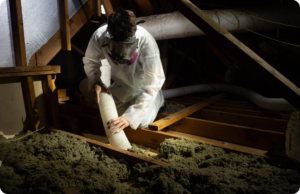The roof is a building’s top covering that protects it against rain, snow, sunlight, and temperature extremes. It consists of a framework of rafters or prefabricated trusses and sheathing boards of plywood or oriented strand board.
Many roofing materials are available in various colors and styles to complement your home. A well-built roof provides protection and insulation and adds to your property value. Contact Corpus Christi Roofing now!

Roofing materials are the outermost layer of a building that shelters it from the elements. The material varies widely from natural products like thatch and slate to synthetic options and metal sheets. The structure of the roof itself also varies from simple timbers to engineered trusses. Regardless of the type or style of roof, there are certain basic materials that all roofs must have to be weatherproof.
Rolled roofing is the mainstay of low-slope residential roofs and outbuildings like shops, sheds and other utilitarian structures. It consists of long rolls of mineral-impregnated and asphalt-impregnated material topped with mineral granules. It is one of the cheapest roofing materials but doesn’t offer much in terms of aesthetic value. It can be rolled onto a roof with either the torch-down method or with roofing nails.
Membrane roofing is a popular option for flat roofs and can be found on commercial buildings as well as homes. This type of roofing uses durable ethylene propylene diene monomer (EPDM) or thermoplastic sheets to create a watertight seal. It is often used for areas that are prone to leaks or as a layer under green roofs.
Clay or concrete tiles are a high-end roofing choice that’s commonly seen in regions with Mediterranean- or Spanish-style architecture. They are extremely durable and offer a classic look that enhances curb appeal. However, they are also heavier than other roofing materials and may require a reinforced roof structure to support them.
Shingles are the most common roofing material in the United States, and they can be made from a wide variety of materials. They’re affordable, easy to install and can help protect a roof from moss and mildew. However, shingle roofs don’t last as long as other types of roofing and can be more prone to leaking in areas with heavy rain.
Metal roofing is becoming more popular, as it offers durability and energy efficiency. It can be built in a variety of styles and is available in steel, aluminum, copper and zinc. There are even composite options that combine the best of both worlds, offering longevity and a rustic look with the added bonus of fire resistance.
Installation
The roof is the top covering of a building, designed to protect against rain, snow, sunlight, wind, and extremes of temperature. It also provides insulation and enhances the visual appeal of a structure. A roof can be constructed in a variety of shapes, sizes, and materials, such as asphalt shingles, metal, tile, wood, or slate.
Roofing is hard work and requires a lot of climbing, ladders, and other equipment. If you are not comfortable with heights or don’t have the right equipment, it’s best to hire a professional. A good roofer will have several years of experience and be able to complete the job quickly and efficiently.
The installation process includes underlayment, flashing, shingles, and a watertight seal. Depending on the type of roof, there may be other details like ridge vents and eave soffit vents that need to be installed. The valleys of the roof, which are the areas where the slopes meet, must be waterproofed, as well. A special vapor retarder can be used to help prevent leaks in these areas.
The cleanup phase of roofing is important for both the environment and safety. Using protective tarps to cover landscaping and shrubbery will ensure that the debris is contained and won’t blow away or block drains. The cleanup process will also include recycling materials and hauling away trash to ensure that your property is clean and safe after the installation process is finished. A good contractor will also take the time to cover any open drains to prevent shingle debris from clogging them.
Maintenance
A roof is an essential part of a structure, protecting interior space from weather elements. It also provides insulation, structural support and enhances the building’s aesthetics. A building’s roof must be inspected regularly to detect problems and correct them before they escalate into costly repairs. Developing and maintaining a maintenance procedure that is tailored to each roof can ensure the long-term success of the roofing system.
A typical roof inspection should include a thorough check of the shingles, looking for excessive wear and tear, cracking, or signs of mold and mildew. Other important items to look for include leaking at penetration points, flashing problems and the integrity of caulking. Chimneys and vent pipes should be inspected for leaks as well.
Leaks are often caused by poor roof ventilation. An efficient roof will provide adequate air flow and prevent condensation that can lead to ice dams, which in turn cause leaks. Other problems that may occur include a clogged roof drain, which can lead to premature damage of the membrane and structural components of a roof. In extreme cases, ponding water can even result in collapsed roofs.
Other areas to check are the condition of stairways, crossovers and platforms. If these are not maintained properly, they can become dangerous to maintenance workers and create an unsafe working environment. It is also a good idea to make sure the proper safety equipment and warnings are posted, particularly if there is electrical work, harmful chemicals or hot equipment on the rooftop.
Another common maintenance item is to trim tree branches, which can hang over the roof and cause damage in heavy storms or natural disasters. This can be especially important in locations that experience a lot of severe weather events.
Repairs
The best way to protect the life of a roof is through preventive maintenance. Regular inspections by a certified roofer allow for early detection of problems like missing or loose shingles, holes and cracks, or leaking spots. Repairing these issues right away prevents them from spreading, which can lead to bigger and more expensive repairs down the road.
Roofing repairs typically involve replacing or covering up damaged areas of the roof with new materials. This is often more cost-effective than a full roof replacement, and offers a good solution for homeowners who wish to keep their existing home.
When repairing flashing, it’s important to try and match how the previous piece was fixed on the roof. This is usually through nails and sealant, and can be a challenge because flashing is often interwoven into the shingle courses. A good place to start is by carefully removing the old piece, and then examining how it was fixed. Once you’ve determined how to reattach the flashing, nail it in place, and then apply a coat of sealant over the area.
There are also a few other points on the roof that may need extra attention, such as pipe boots and drip edge. These are pieces of metal or rubber that cover the base of your ventilation pipes and other systems on the roof, to help keep water and debris out of them.








